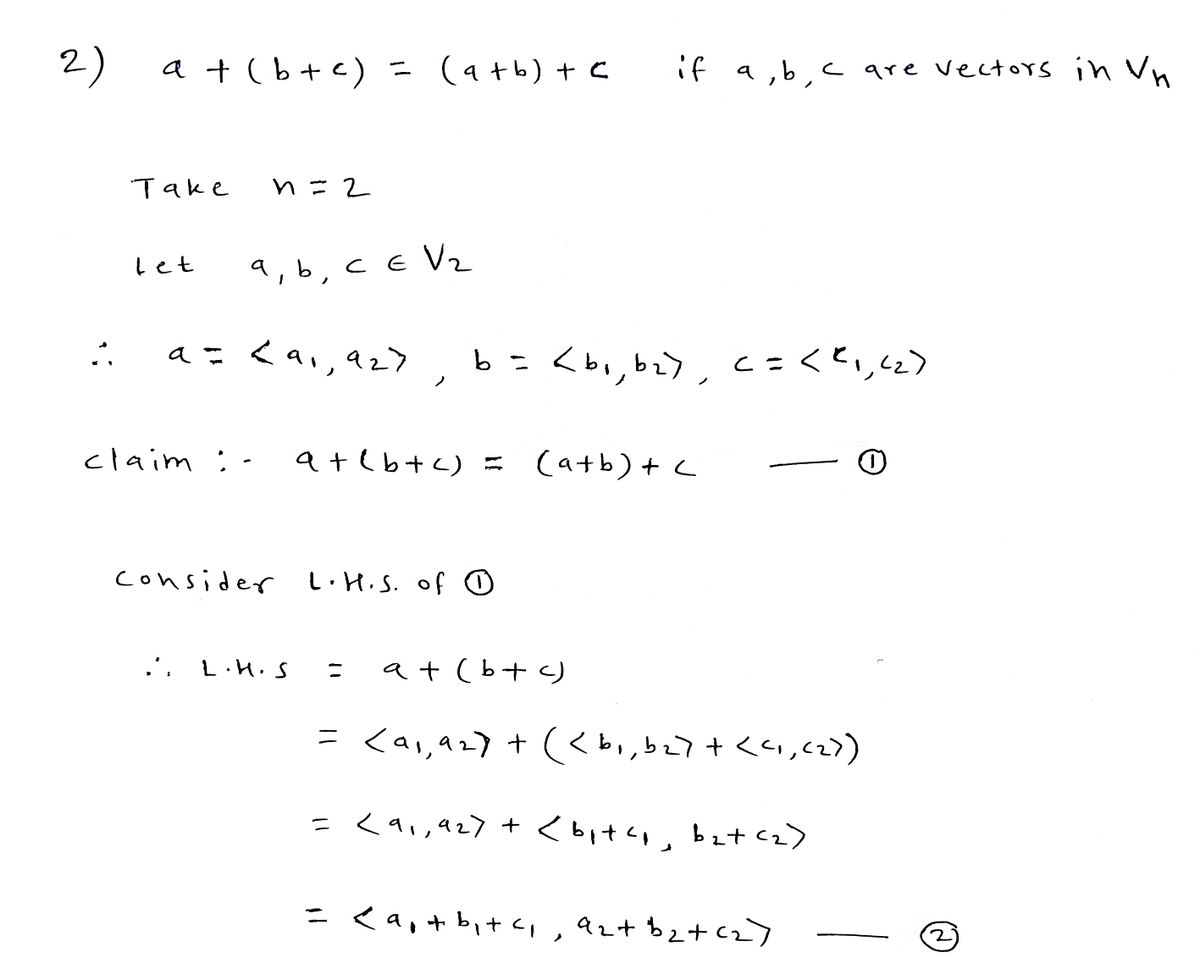49. Figure 16 gives a geometric demonstration of Property 2 of vectors. Use components to give an algebraic proof of this fact for the case n = 2.
49. Figure 16 gives a geometric demonstration of Property 2 of vectors. Use components to give an algebraic proof of this fact for the case n = 2.
Advanced Engineering Mathematics
10th Edition
ISBN:9780470458365
Author:Erwin Kreyszig
Publisher:Erwin Kreyszig
Chapter2: Second-order Linear Odes
Section: Chapter Questions
Problem 1RQ
Related questions
Question

Transcribed Image Text:49. Figure 16 gives a geometric demonstration of Property 2 of
vectors. Use components to give an algebraic proof of this
fact for the case n = 2.

Transcribed Image Text:802
Vectors in n dimensions are used to list
various quantities in an organized way.
For instance, the components of a six-
dimensional vector
P= (P₁, P2, P3, Pa. Ps. Po)
might represent the prices of six dif-
ferent ingredients required to make a
particular product. Four-dimensional
vectors (x, y, z, t) are used in relativity
theory, where the first three compo-
nents specify a position in space and the
fourth represents time.
(a + b) + c
= a + (b + c)
FIGURE 16
CHAPTER 12 Vectors and the Geometry of Space
Q
85923
a+b
C
b+c
a
b
n-dimensional vectors. An n-dimensional vector is an ordered n-tuple:
We denote by V₂ the set of all two-dimensional vectors and by V, the set of all three
dimensional vectors. More generally, we will later need to consider the set V. of a
a = (a₁, a2, ..., An)
where a, a2,..., an are real numbers that are called the components of a. Addition and
scalar multiplication are defined in terms of components just as for the cases n = 2 and
n = 3.
FIGURE 17
Standard basis vectors in V₂ and V3
Properties of Vectors If a, b, and c are vectors in V, and c and d are scalars, then
1. a + b = b + a
2. a + (b + c) = (a + b) + c
4. a + (-a) = 0
3. a + 0 = a
5. c(a + b) = ca + cb
6. (c + d)a = ca + da
8. la = a
7. (cd)a = c(da)
These eight properties of vectors can be readily verified either geometrically or alge
braically. For instance, Property 1 can be seen from Figure 4 (it's equivalent to the Paral
lelogram Law) or as follows for the case n = 2:
a + b = (a₁, a₂) + (b₁,b₂) = (a₁ + b₁, a₂ + b₂)
= (b₁ + a₁, b₂ + a₂) = (b₁,b₂) + (a₁, a₂)
We can see why Property 2 (the associative law) is true by looking at Figure 16 and
applying the Triangle Law several times: the vector PQ is obtained either by first con-
structing a + b and then adding e or by adding a to the vector b + c.
Three vectors in V3 play a special role. Let
i = (1, 0, 0)
УА
(0, 1)-
j
= b + a
These vectors i, j, and k are called the standard basis vectors. They have length 1 and
point in the directions of the positive x-, y-, and z-axes. Similarly, in two dimensions we
define i = (1, 0) and j = (0, 1). (See Figure 17.)
0
(a)
i
j = (0, 1, 0)
(1,0)
k = (0, 0, 1)
X
ZA
k
i
(b)
j
Expert Solution
Step 1

Trending now
This is a popular solution!
Step by step
Solved in 2 steps with 2 images

Recommended textbooks for you

Advanced Engineering Mathematics
Advanced Math
ISBN:
9780470458365
Author:
Erwin Kreyszig
Publisher:
Wiley, John & Sons, Incorporated

Numerical Methods for Engineers
Advanced Math
ISBN:
9780073397924
Author:
Steven C. Chapra Dr., Raymond P. Canale
Publisher:
McGraw-Hill Education

Introductory Mathematics for Engineering Applicat…
Advanced Math
ISBN:
9781118141809
Author:
Nathan Klingbeil
Publisher:
WILEY

Advanced Engineering Mathematics
Advanced Math
ISBN:
9780470458365
Author:
Erwin Kreyszig
Publisher:
Wiley, John & Sons, Incorporated

Numerical Methods for Engineers
Advanced Math
ISBN:
9780073397924
Author:
Steven C. Chapra Dr., Raymond P. Canale
Publisher:
McGraw-Hill Education

Introductory Mathematics for Engineering Applicat…
Advanced Math
ISBN:
9781118141809
Author:
Nathan Klingbeil
Publisher:
WILEY

Mathematics For Machine Technology
Advanced Math
ISBN:
9781337798310
Author:
Peterson, John.
Publisher:
Cengage Learning,

